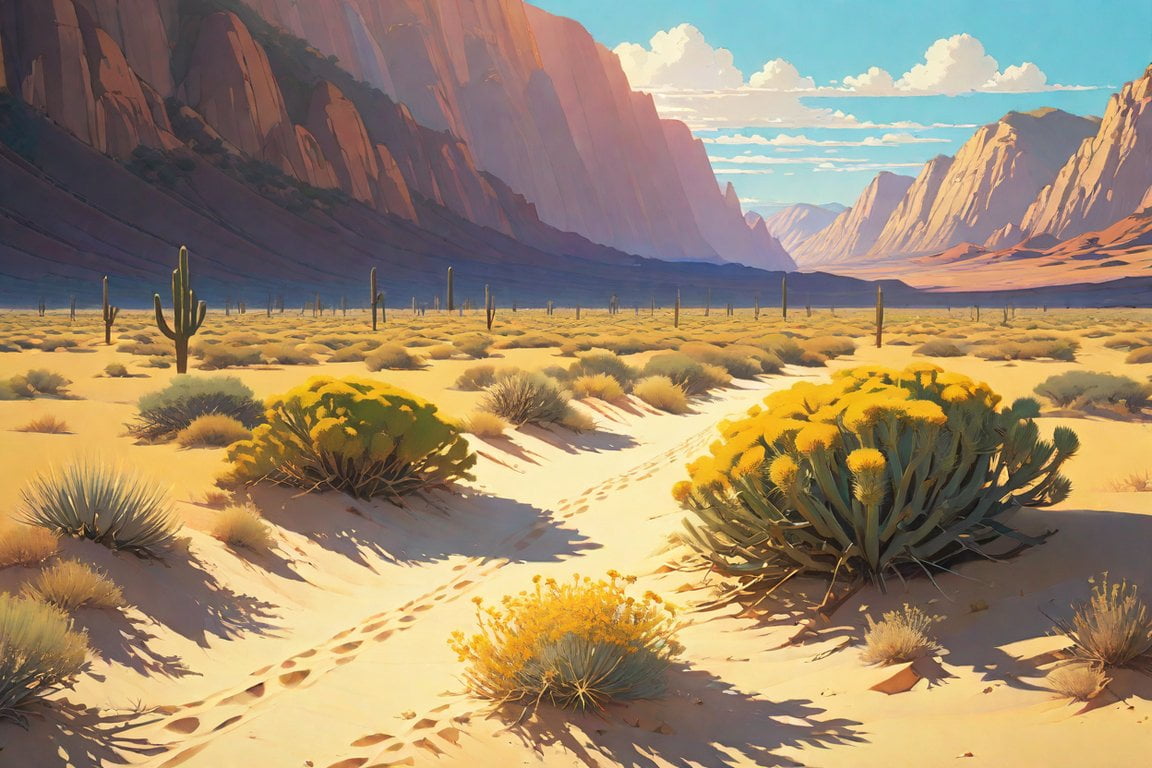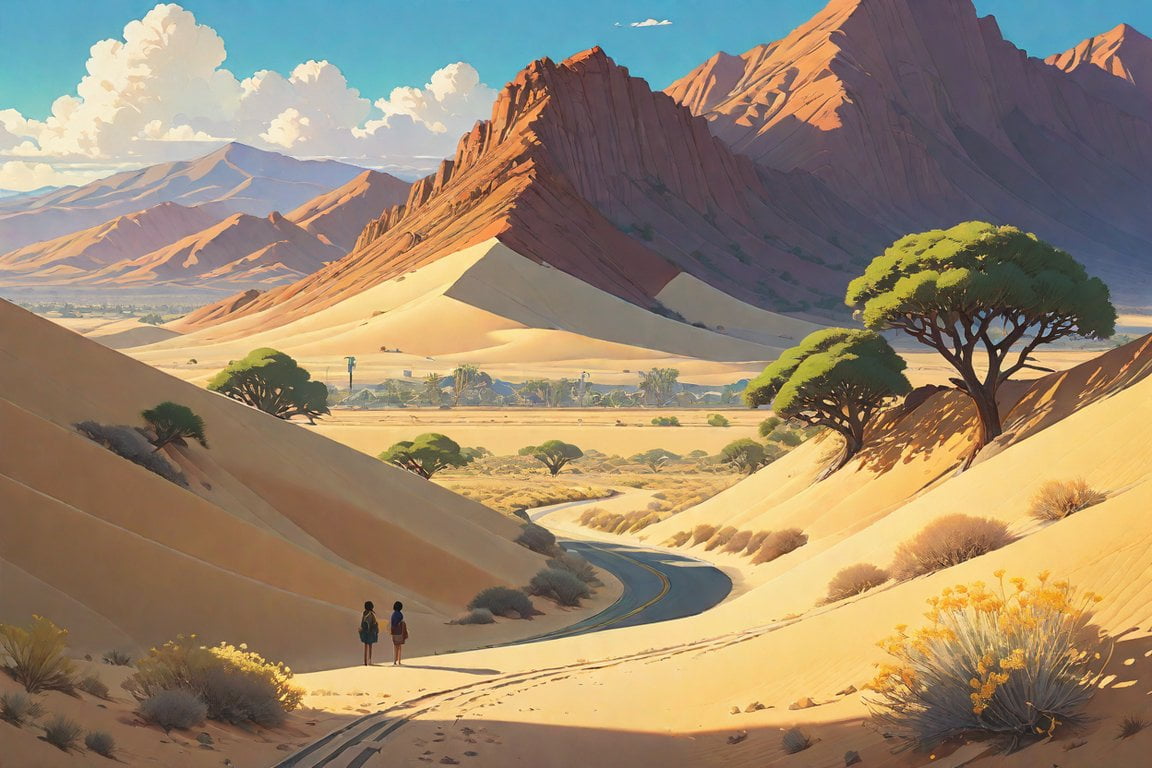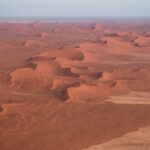Embark on a captivating journey through the arid terrains of the California Desert as we reveal fascinating facts about this mesmerizing region. Known for its unique flora, fauna, and geological formations, the California Desert is a true treasure trove of natural wonders. Take a moment to delve into the enchanting world of this remarkable landscape and discover the extraordinary secrets it holds. Join us as we explore the wonders of the California Desert: Fascinating Facts.
Key Takeaways:
- The California Desert is a vast and diverse region, home to three main deserts: The Great Basin Desert, Colorado Desert, and Mojave Desert.
- The average temperature in the California Desert is around 70 degrees Fahrenheit, making it an inviting destination for warm weather seekers. However, Death Valley National Park can reach scorching temperatures of up to 129 degrees Fahrenheit.
- The California Desert is known for its natural features, including giant sand dunes, towering rock formations, and iconic Joshua Trees.
- It is home to several renowned National Parks, including Death Valley, Joshua Tree, and Manzanar National Historic Site. These parks offer visitors a chance to explore unique landscapes, enjoy springtime wildflowers, and experience star-studded festivals.
- The desert region is teeming with a variety of plants and animals adapted to the harsh environment, including Yucca, cacti, Joshua Trees, bighorn sheep, coyotes, and rattlesnakes.
- Before European settlers arrived, the California Desert was inhabited by Native American tribes who had a deep connection to the land and its resources.
- The California Desert continues to awe and inspire visitors from all walks of life with its diverse deserts, unique ecosystems, and rich cultural heritage.
Facts about California Desert Region

Climate and Natural Features
The California Desert region is a land of extremes. With an average temperature of around 70 degrees Fahrenheit, it offers warm and inviting weather for visitors seeking sunshine and warmth. However, within this region lies Death Valley National Park, known as the hottest place on Earth, where temperatures can reach a scorching 129 degrees Fahrenheit. It’s a stark reminder of the intense heat that can be experienced in this unique desert landscape.
The natural features of the California Desert are awe-inspiring. From giant sand dunes that seem to stretch endlessly to towering rock formations that defy gravity, this region is a testament to the power of nature. Take, for example, the iconic Joshua Trees that proudly stand amidst the arid terrain. With their twisted branches and distinctive silhouette, they have become an iconic symbol of the California Desert.
National Parks and Tourism
One of the main attractions of the California Desert region is its collection of renowned National Parks. Death Valley, Joshua Tree, and Manzanar National Historic Site are just a few examples of the parks that offer visitors a chance to explore the unique landscapes and delve into the rich cultural heritage of the area. These parks are not only home to breathtaking natural wonders but also host star-studded festivals and provide opportunities to witness the beauty of springtime wildflowers.
The California Desert’s allure has made it a popular tourist destination, attracting visitors from all over the world. Its diverse landscapes, from the rugged and stark beauty of Death Valley to the Joshua Tree-studded vistas, offer a unique and memorable experience for those seeking an adventure in this desert paradise.
Flora and Fauna
Despite the harsh conditions, the California Desert is teeming with life. Adapted to survive in this arid environment, a variety of plants and animals have made this region their home. The desert’s flora includes resilient species like yucca, cactus, and the iconic Joshua Trees. These plants have evolved fascinating adaptations to thrive in the arid conditions, with some even relying on specialized pollinators for their survival.
When it comes to fauna, the California Desert is home to an array of wildlife. Bighorn sheep gracefully navigate the rocky terrain, while coyotes stealthily roam the arid plains. Rattlesnakes, with their unique adaptations, also call this region their home. Before the arrival of European settlers, Native American tribes had a deep connection to the land and its resources, further enriching the biodiversity and cultural heritage of the California Desert.
In Conclusion
The California Desert region is a captivating and diverse landscape, encompassing three main deserts and offering a cornucopia of natural wonders and cultural heritage. From the extreme temperatures of Death Valley to the grandeur of Joshua Tree National Park, there is something for everyone to explore and appreciate in this remarkable desert landscape. Whether it’s marveling at the resilience of desert flora or catching a glimpse of elusive desert wildlife, the California Desert continues to inspire and draw visitors from all walks of life.
[NOTE: Please add appropriate H3 subtitles to the content as required.]
Sources:
[^1^]: Facts Mania. (n.d.). California Desert Facts. Retrieved from factsmania.org
[^3^]: Visit California. (n.d.). Discover the Deserts. Retrieved from visitcalifornia.com
- What is a fact-finding hearing – Curious to know more about what happens during a fact-finding hearing? Click here to unravel the process and gain a better understanding.
- Accessory after the fact Louisiana – Dive into the intriguing realm of criminal law by exploring the concept of “accessory after the fact” in Louisiana. Find out the legal implications behind this term by clicking here.
- Facts about the color black – Did you know that the color black holds fascinating secrets and symbolism? Click here to get enlightened with intriguing facts about the enigmatic hue.
- Facts about Perito Moreno Glacier – Prepare to be captivated by the awe-inspiring beauty of Perito Moreno Glacier. Click here to explore fascinating facts about this majestic natural wonder and get ready to be amazed.
Various iconic national parks are located in the California desert region, such as Joshua Tree National Park and Death Valley National Park.
From the towering rock formations to the unique desert ecosystems, the California desert region is home to some of the most iconic national parks in the United States. Joshua Tree National Park and Death Valley National Park stand out as magnificent examples of the diverse landscapes and natural wonders found in this arid yet captivating region.
Key Takeaways:
- Joshua Tree National Park and Death Valley National Park are two iconic national parks in the California desert region.
- Joshua Tree National Park showcases the meeting point of the Mojave and Colorado deserts, supporting distinct desert ecosystems.
- The park boasts a rich variety of plants and animals that have adapted to survive in the harsh desert environment.
- Visitors to Joshua Tree National Park can enjoy activities such as hiking, climbing, and bouldering, as well as stargazing in the park’s renowned dark night skies.
- The park has a fascinating geological history, with its oldest rocks estimated to be 1.7 billion years old.
- Its creation is owed to the efforts of Minerva Hoyt, a former socialite, and various acts of legislation.
- Death Valley National Park, on the other hand, is known for its extreme temperatures and unique natural features.
- With average temperatures reaching as high as 129 degrees Fahrenheit, it holds the record for the hottest place on Earth.
- The park showcases vast sand dunes, towering rock formations, and strikingly beautiful salt flats.
- Despite its harsh conditions, Death Valley is home to a surprising variety of plant and animal species.
- Visitors can explore the park’s stunning landscapes, hike through canyons, and marvel at the otherworldly beauty of places like Badwater Basin and Mesquite Flat Sand Dunes.
The Desert’s Hidden Treasures: Unveiling the Fascinating Biodiversity
Have you ever wondered how life manages to thrive in the harsh, arid conditions of the desert? Contrary to popular belief, deserts are far from barren wastelands. In fact, the desert is rich in biodiversity, harboring numerous plant and animal species that have adapted to these challenging environments. Join me as we venture into the depths of the California desert region and uncover the wonders of its diverse and resilient ecosystems.
The Hidden Oasis of Life
Deserts may be regarded as inhospitable due to their extreme dryness, but beneath their seemingly lifeless surface lies a hidden oasis of biodiversity. These unique habitats support an astonishing variety of species, each with its own remarkable adaptations to survive the harsh conditions.
Unveiling the Flora
The desert is home to a plethora of fascinating plant species that have evolved ingenious strategies to cope with the scarcity of water. From resilient cacti with their succulent stems to the majestic Joshua Trees silhouetted against the desert skies, the flora of the California desert region is a sight to behold. These plants not only capture our imagination with their unique forms but also play crucial roles in maintaining the delicate balance of desert ecosystems.
A Haven for Resilient Fauna
While the plant life in the desert may steal the show, the animal species that call this region home are just as captivating. Adapted to survive in the harsh desert environment, these creatures have developed extraordinary features and behaviors. From the majestic bighorn sheep gracefully navigating rugged landscapes to the elusive coyotes prowling in search of their next meal, the wildlife of the California desert region is a testament to the resilience of life.
Secrets of Survival
Surviving in the desert is no easy feat. The scarcity of resources, including food and water, poses numerous challenges for both organisms and humans alike. However, the plants and animals of the desert have found innovative ways to overcome these obstacles. The desert is rich in biodiversity, harboring numerous plant and animal species that have adapted to the harsh conditions. The ability to store water, deep-rooted systems, and specialized behaviors are just a few of the many strategies employed by desert-dwelling species. It is a constant battle for survival, with each organism equipped with unique survival mechanisms.
Discovering the Desert’s Wonders
The California desert region is a treasure trove of natural wonders, with renowned national parks like Joshua Tree and Death Valley inviting visitors to explore their stunning landscapes. These protected areas not only provide a glimpse into the unique ecosystems of the desert but also offer opportunities for adventure and appreciation of its cultural heritage.
Key Takeaways:
- The desert is rich in biodiversity, with a variety of plant and animal species adapted to survive in harsh conditions.
- Desert ecosystems are characterized by unique adaptations and strategies for survival.
- The flora of the California desert region includes resilient species like cacti and Joshua Trees.
- The fauna of the desert includes fascinating creatures such as bighorn sheep and coyotes.
- The desert is a challenging environment, and organisms have evolved specialized features to thrive in this hostile landscape.
Learn more about deserts – Britannica
Explore desert facts and information – National Geographic
The California desert region faces significant environmental challenges, including water scarcity and the threat of wildfires.
The California desert region, with its stunning landscapes and diverse flora and fauna, is not only a place of beauty but also a region facing significant environmental challenges. In recent years, the region has been grappling with two major issues: water scarcity and the threat of wildfires. These challenges have far-reaching consequences for the fragile ecosystems and the communities that call this arid region home.
Water Scarcity: A Looming Crisis
One of the most pressing environmental challenges in the California desert region is water scarcity. As of September 2021, a staggering 88 percent of the state of California was experiencing an extreme drought, with 47 percent classified as exceptional drought, the most severe categorization. This severe drought has dire implications for both the environment and human populations.
Long-term exceptional droughts can have devastating effects on the region. Land subsidence, or the sinking of the land, becomes a concern as underground aquifers are depleted. This can lead to structural damage to buildings, roads, and infrastructure. Moreover, the severe ecological disruption caused by water scarcity can result in the loss of crucial habitats for plants and animals, leading to a decline in biodiversity.
The Threat of Wildfires
In addition to water scarcity, the California desert region also faces the constant threat of wildfires. The prolonged drought conditions, coupled with high temperatures and dry vegetation, create the perfect conditions for wildfires to spread rapidly and become increasingly intense.
The consequences of wildfires in the desert are far-reaching. They pose a severe risk to human lives, destroy homes and infrastructure, and have a detrimental impact on the delicate ecosystems that exist in the region. Native plant species, many of which are uniquely adapted to survive the harsh desert environment, can be wiped out by the intense heat and flames of wildfires. This loss of plant life disrupts the complex web of life in the desert, affecting the diversity and resilience of the ecosystem.
Challenges Faced by Desert Cities
Desert cities in the California desert region face their own set of challenges in addressing water scarcity and preventing wildfires. These cities rely on high-energy-use infrastructures to supply water from large hydraulic hinterlands. However, these infrastructures often compete for scarce water resources with other cities, the environment, and agricultural needs.
As the demand for water increases due to rapid growth and climate change, desert cities must navigate the delicate balance between meeting the needs of their growing populations and safeguarding the natural resources that make the California desert region so unique. The allocation of water resources becomes a complex and contentious issue that requires innovative solutions and careful planning to ensure both human and environmental needs are met.
Preserving the California Desert Region
Despite the challenges it faces, the preservation of the California Desert Region is of utmost importance. This captivating and awe-inspiring landscape plays a crucial role in fighting climate change and securing the region’s future. The desert’s unique ecosystems sequester carbon dioxide, helping to mitigate the impacts of greenhouse gas emissions. Additionally, preserving the desert’s natural beauty and biodiversity ensures that future generations can continue to appreciate and learn from its wonders.
Protecting the California Desert Region requires a multifaceted approach. It involves implementing sustainable water management practices, reducing water usage, and investing in alternative sources such as desalination and water recycling. It also necessitates careful management of firefighting resources, including measures to prevent wildfires and promote fire-resistant landscapes.
By addressing both water scarcity and the threat of wildfires, we can strive towards a future where the California desert region thrives while maintaining its delicate balance of nature and human presence.
Key Takeaways:
- The California desert region is facing severe environmental challenges, including water scarcity and the threat of wildfires.
- The region is currently experiencing an extreme drought, with almost 90 percent of the state classified as exceptional drought.
- Long-term exceptional droughts can lead to land subsidence, severe ecological disruption, low agricultural yields, and poor water quality.
- The threat of wildfires in the desert is intensified by drought conditions, high temperatures, and dry vegetation.
- Wildfires pose risks to human lives, destroy habitats, and disrupt the delicate balance of desert ecosystems.
- Desert cities must navigate the complex challenge of balancing water supply for growing populations with preserving the environment and meeting agricultural needs.
- Preserving the California Desert Region is crucial for fighting climate change and ensuring the region’s future.
- Sustainable water management, prevention measures against wildfires, and investing in alternative water sources are essential for preserving the region’s natural beauty and biodiversity.

FAQ
Q1: What is the current status of drought in California?
A1: As of September 2021, 88 percent of the state of California was experiencing an extreme drought, with 47 percent categorized as exceptional, the most severe drought categorization.
Q2: What are the potential impacts of long-term exceptional droughts in California?
A2: Long-term exceptional droughts can lead to various negative impacts, including land subsidence, severe ecological disruption, increased severity and intensity of wildfires, widespread water shortages, low agricultural yields, high water prices, and poor water quality.
Q3: How do desert cities in California supply water in the midst of water scarcity?
A3: Desert cities in California rely on high-energy-use infrastructures to supply water from large hydraulic hinterlands. However, these infrastructures often compete for scarce water with other cities, the environment, and agriculture.
Q4: Why is the preservation of the California Desert Region important?
A4: The preservation of the California Desert Region is essential for its remarkable abilities to fight climate change and ensure the region’s future.
Q5: Are desert cities in California vulnerable to future water scarcity?
A5: Yes, arid regions and their cities, including desert cities in California, are vulnerable to future water scarcity due to climate change and rapid growth, which increases demand for water.
- Unveiling the Enigma: Mansoureh Khojasteh Bagherzadeh’s Public Appearances & Private Life in Iran - July 18, 2025
- Unveiling the Mystery: Mansoureh Khojasteh Bagherzadeh’s Husband: A Rare Glimpse into a Private Life - July 18, 2025
- Unveiling Masoud Khamenei’s Mother: Power, Influence, and Iran’s Future - July 18, 2025
















